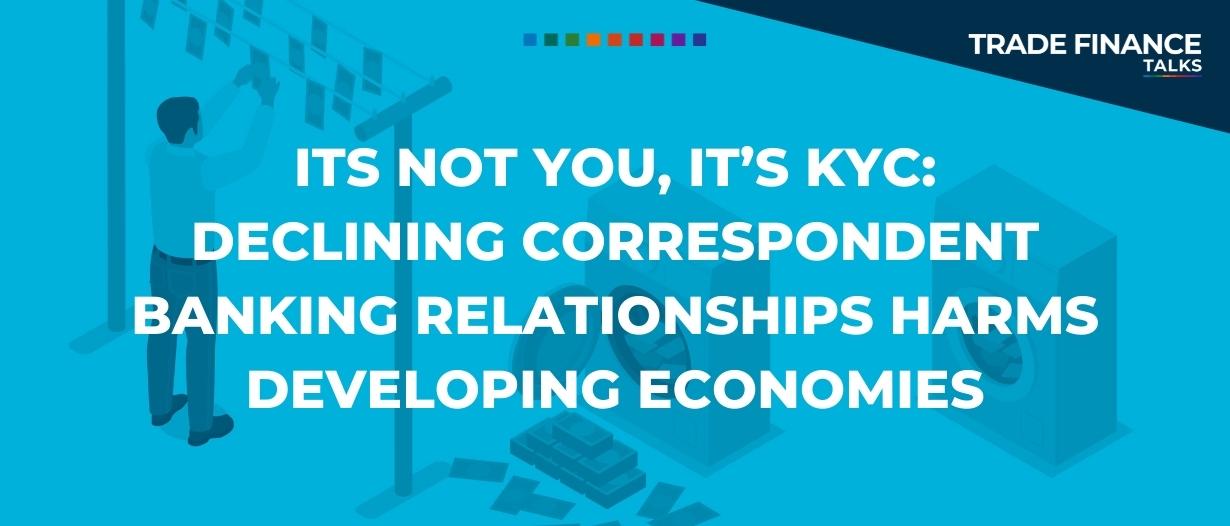Correspondent banks are a key part of cross-border payments facilitating the flow of trade between different jurisdictions.
A correspondent bank holds the deposits of another bank (the respondent bank) allowing the respondent to use the correspondent bank’s services.
The banks are usually located in different jurisdictions, this relationship allows the respondent bank to settle transactions in the correspondent banks jurisdiction and vice versa.
Respondents that have deposits with the correspondent bank need financial messaging and governance systems that meet the standards set by the correspondent bank regulatory authorities to operate a legal relationship.
A correspondent banking example:
Corporate A needs to settle a transaction by sending funds to corporate B, but they operate in different jurisdictions and currencies.
Corporate A, holds deposits with Bank A which is in country A.
Corporate B holds deposits in bank B within country B.
Bank A (the respondent bank), in country A has a correspondent banking relationship with Bank B in country B.
Bank A can settle the transaction with Bank B.
Even if corporate B isn’t with Bank B, corporate B can use Bank B’s services to settle the transaction with Corporate B’s chosen bank in country A.
Correspondent banks review these relationships periodically and decide whether to continue with the relationship or to withdraw.
Over the last decade, the decision has been leaning towards the latter.
The importance of correspondent banking
Correspondent banking relationships are crucial for banks that offer trade finance services.
In an emerging market economy (EME) context, the banks in developed economies can support their corporates in settling trade transactions with corporates in EMEs and vice versa.
Banks with correspondent banking relationships don’t necessarily derive profit from correspondent banking services themselves, but the cross-border payment and messaging system allows them to offer other products such as trade finance services.
The correspondent banking landscape
Presently, the trend in correspondent banking is a sustained reduction in the number of relationships.
Correspondent banks tend to operate internationally and follow international standards, usually adhering to US financial regulations in order to secure access to US financial markets.
This means that respondent banks will have to meet these international requirements adding additional costs.
For example, international correspondent banks must meet the standards that are suggested by the Financial Action Task Force (FATF) for global standards for anti-money laundering (AML) and counter terrorist financing (CTF).
These factors have led to the withdrawal of relationships.
The International Finance Corporation (IFC) suggests that the correspondent banks are derisking where the low margins are not enough to justify the added risk.
According to data from Bank for International Settlements (BIS), the value and volume of cross-border payments increased by 2% and 7%, respectively, in 2020, while correspondent banking relationships contracted by 4% that same year, creating a total decline of about 25% from 2011 to 2020.
This can be attributed to the change in the lending environment over the last decade.
More robust financial regulation through capital controls as well as stricter compliance regulation has led to a reduction in risk appetite.
A 2021 report from the Leibniz Centre for European Economic Research (ZEW) found that the costs of due diligence and financial crime compliance are reducing risk appetite.
This in turn leads to a reduction in profitability and increased risk of fines, which collectively put significant strain on correspondent banking relationships.
Specifically, this strain has led to a withdrawal of relationships in jurisdictions where there was a history of both weak compliance practices and money laundering.

Consequences of the correspondent banking landscape
A reduction in correspondent banking relationships increases the difficulty of settling cross-border transactions.
ZEW, found that between 2013 and 2019, banks finding it “difficult or impossible to access dollars” increased from 7% to 26%.
They also found that the export growth rate was 6-8% lower for countries with a “high withdrawal of correspondent banks” compared to countries with “low withdrawal” rates.
However, it is important to note that this correlation could be due to other macroeconomic factors within the countries that contributed to both poor export growth and hastened correspondent bank withdrawal rather than the influence of one on the other.
Either way, the effects of the reduction in correspondent banking relationships remain.
Longer payment chains
While there is a marked loss of relationships, completely losing access to the global financial system is rare.
The BIS found that virtually all jurisdictions maintained corridors from and to banks in BIS reporting countries despite the reduction in the number of relationships.
This has led to a shift in the structure of the correspondent banking network.
ZEW’s survey in the region where the European Bank for Reconstruction and Development (EBRD) operates found that, between 2013 and 2019, the share of correspondent banking relationships with US and German banks fell from 75% to 54%.
BIS hypothesised that the correspondent relationships have become more concentrated with fewer banks, finding that the number of active correspondents on SWIFT decreased but the volume of messages increased.
This suggests that there are longer-payment chains where the buyer’s payments go through multiple banks to get to the supplier, leading to more time and transaction costs when settling cross-border payments.
In the case of remittances, formal channels for international payments that provide protection for individuals lead to them using riskier methods, like cryptocurrencies.
This is a problem where there is an increase in the value of global remittances at the same time as a decrease in the number of correspondent banking relationships.

Reversing the decline
There are calls for the industry to cooperate to resolve the challenges to banks in building and maintaining correspondent banking relationships.
In a 2016 paper, BIS argued that due to correspondent banking’s importance to the functioning of international trade, stakeholders should cooperate to improve the efficiency of the regulatory framework and systems that it operates on.
There are also calls tha on the supply-side respondent banks should step up to international standards.
ZEW, suggests that emerging market respondent banks should play a role in supporting the correspondent banking network by making sure that their compliance and risk procedures are up to international standards.
This will help by reducing both onboarding costs and correspondent bank risk.
One specific policy is that the staff should get sufficient training and recognised professional qualifications for compliance practices.
However, these investments need to be commercially viable for the banks to implement
The industry needs to know whether the investments in the building of supply by increasing respondent bank capabilities will be met by greater engagement from correspondent banks.
There are already financial products that still incentivise demand for trade finance and thus correspondent banks.
For example, the use of trade credit insurance from insurers and export credit guarantees from governments distribute the risk of a transaction.
All said, the correspondent banking relationships are a key part of international trade and the trade finance community would greatly benefit from a resurgence in correspondent banking.
Read the latest issue of Trade Finance Talks, June 2022

 Australia
Australia Hong Kong
Hong Kong Japan
Japan Singapore
Singapore United Arab Emirates
United Arab Emirates United States
United States France
France Germany
Germany Ireland
Ireland Netherlands
Netherlands United Kingdom
United Kingdom










Comments are closed.